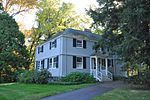North Easton station
1855 establishments in MassachusettsBuildings and structures in Bristol County, MassachusettsEaston, MassachusettsFormer Old Colony Railroad stationsFormer railway stations in Massachusetts ... and 13 more
Henry Hobson Richardson buildingsHistoric American Buildings Survey in MassachusettsHistoric district contributing properties in MassachusettsMBTA Commuter Rail stations in Bristol County, MassachusettsNRHP infobox with nocatNational Register of Historic Places in Bristol County, MassachusettsProposed MBTA Commuter Rail stationsRailway stations in the United States closed in 1958Railway stations in the United States opened in 1855Railway stations on the National Register of Historic Places in MassachusettsRailway stations scheduled to open in 2030Richardsonian Romanesque architecture in MassachusettsUse mdy dates from August 2023

North Easton station is a former railroad station designed by noted American architect H. H. Richardson. It is located just off Oliver Street in North Easton, Massachusetts, and currently houses the Easton Historical Society. The station was built in 1881 and served commuter trains until 1958. It was added to the National Register of Historic Places in 1972 as Old Colony Railroad Station. In 1987, it also became part of the H. H. Richardson Historic District of North Easton, a National Historic Landmark District. The proposed Phase 2 of South Coast Rail would return commuter rail service to the location in 2030 as Easton Village station.
Excerpt from the Wikipedia article North Easton station (License: CC BY-SA 3.0, Authors, Images).North Easton station
Mechanic Street,
Geographical coordinates (GPS) Address External links Nearby Places Show on map
Geographical coordinates (GPS)
| Latitude | Longitude |
|---|---|
| N 42.069269444444 ° | E -71.103319444444 ° |
Address
North Easton Station
Mechanic Street 80
02356
Massachusetts, United States
Open on Google Maps







